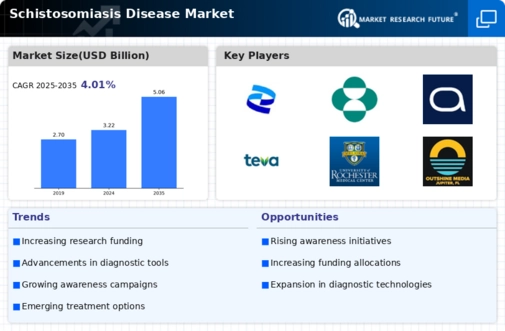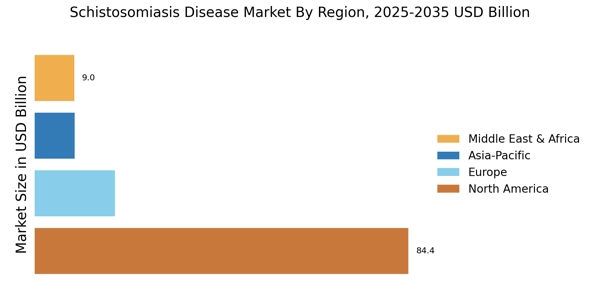Growing Public Health Awareness
Public health campaigns aimed at raising awareness about schistosomiasis are becoming more prevalent, which may positively influence the Schistosomiasis Disease Market. Increased awareness among communities about the transmission, symptoms, and prevention of schistosomiasis is likely to lead to higher demand for diagnostic and treatment options. Educational initiatives, often supported by health organizations, are crucial in informing populations at risk, particularly in endemic areas. As communities become more informed, the likelihood of seeking medical assistance increases, thereby driving market growth. This heightened awareness could also encourage governments and organizations to allocate more resources towards combating schistosomiasis, further impacting the Schistosomiasis Disease Market.
Government Initiatives and Funding
Government initiatives aimed at controlling schistosomiasis are likely to play a crucial role in shaping the Schistosomiasis Disease Market. Various countries have implemented national control programs, which often include mass drug administration campaigns. For instance, funding from governmental and non-governmental organizations has been directed towards research and development of new treatments and diagnostic tools. The financial commitment from these entities is expected to bolster the market, as it facilitates the introduction of novel therapies and enhances access to existing treatments. Furthermore, international collaborations and partnerships may emerge, potentially leading to a more coordinated approach in tackling schistosomiasis, thereby influencing the dynamics of the Schistosomiasis Disease Market.
Increasing Prevalence of Schistosomiasis
The rising incidence of schistosomiasis, particularly in endemic regions, appears to be a primary driver for the Schistosomiasis Disease Market. According to estimates, over 200 million individuals are currently infected, with a significant number residing in Africa and parts of Asia. This growing prevalence necessitates enhanced healthcare interventions and treatment options, thereby expanding the market. The World Health Organization has emphasized the need for effective control measures, which may lead to increased funding and research initiatives aimed at combating this disease. As awareness of the disease's impact on public health grows, stakeholders are likely to invest more in developing innovative therapies and preventive strategies, further propelling the Schistosomiasis Disease Market.
Technological Advancements in Diagnostics
Technological advancements in diagnostic tools are expected to significantly influence the Schistosomiasis Disease Market. The development of rapid and accurate diagnostic tests can facilitate early detection and treatment of schistosomiasis, which is essential for effective disease management. Innovations such as point-of-care testing and molecular diagnostics are likely to enhance the ability to identify infections quickly, thereby improving patient outcomes. As these technologies become more accessible, healthcare providers may be more inclined to implement them in endemic regions, potentially increasing the demand for related treatments. This shift towards more efficient diagnostic methods could lead to a transformation in the Schistosomiasis Disease Market, as timely interventions become more feasible.
Rising Investment in Research and Development
The Schistosomiasis Disease Market is witnessing a surge in investment directed towards research and development. Pharmaceutical companies and research institutions are increasingly focusing on discovering new therapeutic agents and vaccines to combat schistosomiasis. Recent data indicates that the global market for schistosomiasis treatments is projected to grow significantly, driven by the need for effective solutions. This investment trend is likely to result in the introduction of innovative treatment modalities, which could enhance patient outcomes and reduce the burden of the disease. Additionally, advancements in biotechnology and genomics may pave the way for more targeted therapies, further stimulating growth within the Schistosomiasis Disease Market.


















Leave a Comment